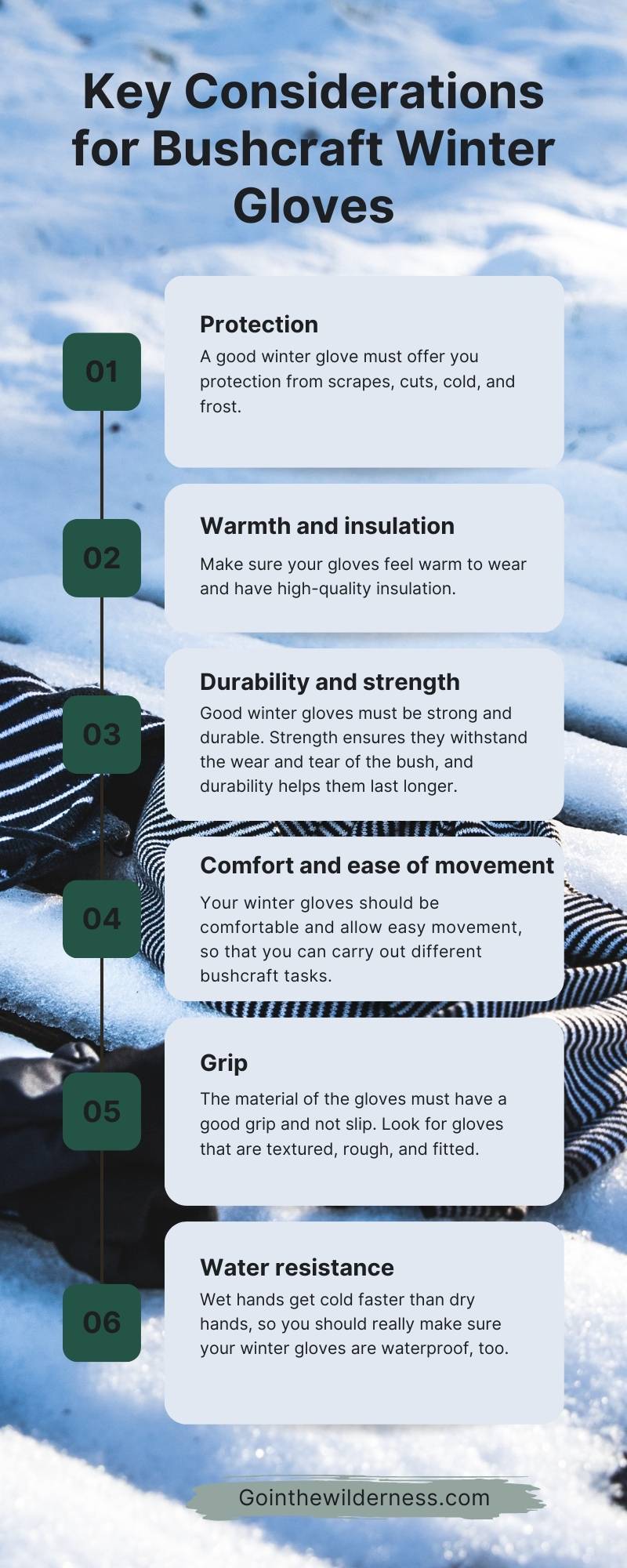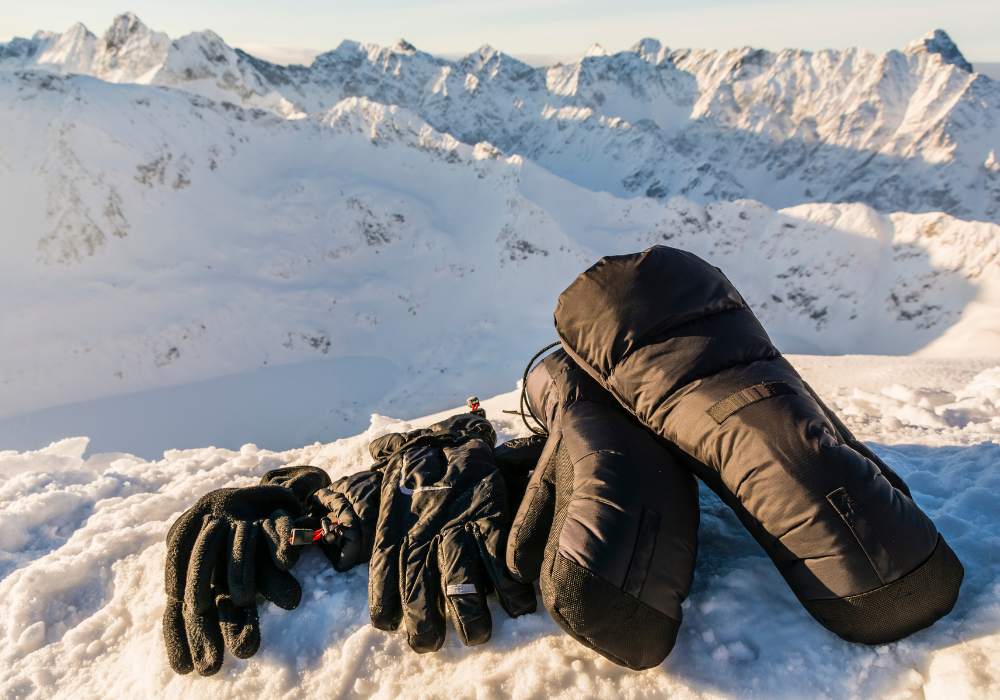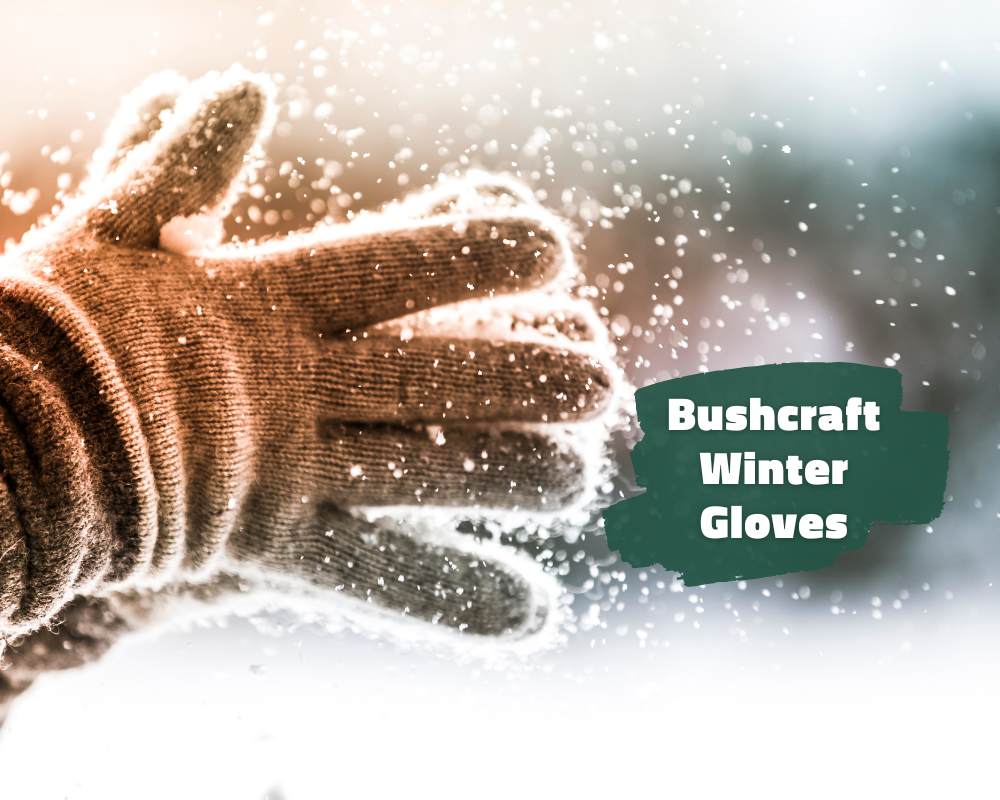Bushcrafting in winter requires not only skill, but the right equipment and clothing. Gloves are a part of that. Cold hands impede many bushcraft activities and can even become frostbitten—so it’s really worth taking your time to find the perfect winter gloves for you.
And so that’s what this guide is all about! You’ll learn what to look for in winter gloves, what different types of gloves there are, which top picks we recommend buying, and how to properly look after and maintain winter gloves.
Key Considerations for Bushcraft Winter Gloves
There are a few main factors you need to consider before buying winter gloves for camping. These are:
- Protection: A good winter glove must offer you protection from scrapes, cuts, the cold, and frost. You’ll be out in the wild so these things are very important. The gloves should completely cover your hands and be thick enough to prevent blisters, splinters, thorns, cold, and other potential threats.
- Warmth and insulation: This links to protection. Make sure your gloves feel warm to wear and have high-quality insulation. This is essential in winter.
- Durability and strength: Good winter gloves must be strong and durable. Strength ensures they withstand the wear and tear of the bush, and durability helps them last longer. As a general rule, thicker materials last longer than thinner materials—so you can expect leather gloves to last longer than cotton ones, for instance.
- Comfort and ease of movement: Don’t forget this key requirement! Your winter gloves should be comfortable and allow easy movement, so that you can carry out different bushcraft tasks—like cooking and woodwork—without having to take them off.
- Grip: While wearing your winter gloves, you will be grabbing tools and objects with your hands a lot. So the material of the gloves must have good grip and not slip. Look for gloves that are textured, rough, and fitted. Without these features, you might drop (and break!) essential pieces of kit.
- Water resistance: Wet hands get cold faster than dry hands, so you should really make sure your winter gloves are waterproof, too.

Types of Bushcraft Winter Gloves
In terms of materials, winter gloves come in two major types:
- Synthetic or man-made gloves: These are waterproof and protect you best against cold and harsh weather.
- Leather gloves: These are a popular choice, but won’t provide quite as much protection as synthetic gloves.
When looking at the different types of gloves, remember to consider the important features like insulation, durability, and comfort. All in all, given their efficacy in cold temperatures, man-made/synthetic gloves are best for the wintertime.
Notably, there are also variations on each type of glove, including: fingerless gloves, fur-lined gloves, fleece gloves, wool gloves, mittens, heated gloves, and flip-back finger gloves, among others. You’ll get to know which variations we recommend in the next section!
Top Picks for Bushcraft Winter Gloves
As discussed, there are different variations of man-made and leather gloves, and some are better for winter usage than others. We have three top picks that we recommend you buy—keep reading to discover them!

Fleece Gloves
Fleece gloves are soft, flexible, and cozy, meaning they’re comfortable to wear and move around in. They also have water-resistant and windproof properties, making them ideal for bushcrafting during the winter.
Snow Mittens
Snow mittens are extra tough and can be used even on the most extreme ice and rugged terrains. They are usually windproof, waterproof, and have extra-warm insulation. Commonly with snow mittens, you have the option to tighten them around your wrists to keep your arms warm.
Performance Gloves
These cardio-based activity gloves serve well in the winter. They fit well and are easy to move around in, as well as preventing cold air from passing through. What’s more, you get the added benefit of breathability—which you don’t get with some other materials that can make your hands sweat.
Tip: A liner glove is another type of performance glove that can serve as a good winter glove for bushcrafting.
Care and Maintenance of Winter Gloves
To care for winter gloves, you need to take several steps.
- Keep your gloves protected from unnecessary contact with germs. For example, avoid touching your face while wearing them.
- Store your gloves in a cool, dry area when not using them. This will help them last longer and prevent mold, wear, and water damage.
- Allow your gloves to air dry after using them. Don’t bundle gloves into bags without giving them time to dry. The sun is a great source of heat for drying gloves!
- Wash your gloves and use a disinfectant to clean the fabrics. This is healthy for both your skin and the gloves. Keep reading for more glove-cleaning tips!
To wash your gloves carefully, follow the following steps:
- Read the labels on your gloves. This is the first thing you need to do after buying your gloves. Check the manufacturer’s labeling and washing instructions and familiarize yourself with the material, insulation, lining, and care.
- Look for individual marks that need removing. You can scrub these off your gloves using a non-harsh detergent.
- Scrub in a gentle, non-aggressive manner. Just because the gloves are made out of tough materials, doesn’t mean they can be treated rough!
- Don’t use the washing machine; hand wash your gloves instead. This will help your gloves stay intact for longer and last longer.
Tip: Don’t ever submerge full-leather gloves in water.
Conclusion
This comprehensive guide to winter gloves should have helped you immensely: you now know what to look for in winter gloves, which types are best for the winter, and how to properly clean and care for winter gloves to maximize their quality and longevity. Come back to this guide whenever you need!
I am Bruno. Navigating the urban rush by day, I find peace under the stars by night. Alongside my loyal companion and co-adventurer Lilith, we explore the balance between city life and nature’s embrace. Through writing and films, I delve into bushcraft and the wild’s allure.
GointheWilderness is my bridge between these two realms, guiding you to reconnect with your innate wilderness.
Eden is here and now; join us in rediscovering it.

